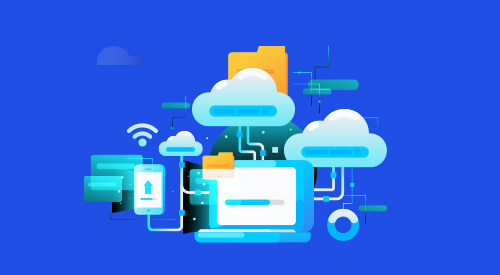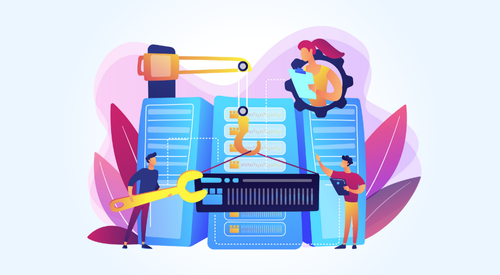

Cloud architecture forms the backbone of any successful cloud strategy, guiding the design, deployment, and management of scalable and secure systems. . As architects, we are responsible for ensuring that all architecture principles and best practices are followed while clients embark on their journey into the Google Cloud Platform (GCP). The foundation of cloud architecture plays a pivotal role in defining the success of cloud adoption. GCP Cloud architecture foundations provide a structured approach to design and manage cloud solutions efficiently, ensuring scalability, security, and cost-efficiency. In this blog, we will delve into the importance of architecture support for businesses adopting GCP, how it helps avoid common pitfalls, and why it ensures better alignment of business goals with cloud capabilities.
Optimize Your Cloud Architecture with Niveus
Architecture refers to the foundational framework that supports the deployment, management, and scalability of applications and services in the cloud. It involves designing and organizing the various components of a system to ensure they work together efficiently and effectively.
Architecture support involves the guidance and tools provided to design, implement, and maintain an effective cloud infrastructure. It includes best practices, frameworks, and solutions that help in optimizing performance, managing resources, and ensuring the reliability of cloud-based systems.
We’ll explore key architecture principles such as system design, operational excellence, and cost optimization, while shedding light on how Niveus Solutions partners with clients to provide end-to-end architecture support on GCP.
Why is Architecture Support Important?
Architectural support is crucial for optimizing performance, ensuring scalability, and managing costs effectively. It provides the framework for maintaining high reliability and availability, safeguarding security, and adhering to compliance requirements. Additionally, it streamlines operations, supports innovation, and enhances overall efficiency, enabling businesses to adapt to evolving needs and technological advancements.
To ensure we get the best value and features from our cloud journey it is important to involve an architect group to help build a roadmap, solution,design and best practices. If not followed, there will be a lot of designs taken by devops on adhoc basis and in a hurry without evaluating all aspects.
This can have different implications including timeline impact, security impact, application un availability/outage, no observability, audit failure or even more serious compliance failures, cost rise, skill gaps, performance implications and excessive efforts and timelines.
This is applicable for platform and applications both as architecture should cover all applications otherwise it becomes unmanageable.
The Importance of Building a Strong Foundation in Business
When starting any business, like selling groceries, it’s crucial to have a business plan in place, along with systems for managing inventory, delivery, security (like cameras and locks), skilled employees, cost management software, and payment systems. While all these elements are important, they can’t all be implemented at once. Their maturity and complexity will evolve over time, depending on the nature of the business and the stage of its journey.
However, having a framework and roadmap from the beginning ensures that the right tools are set up, skills are developed, and systems are enhanced over time. Agility, along with strong processes and a forward-thinking mindset, forms the foundation that makes this progression possible. This framework helps assess the requirements and map out solutions, ensuring all aspects of the business are considered and addressed effectively.
How is it done?
Building a robust cloud architecture requires a systematic approach that ensures all aspects of the business and IT landscape are covered. From understanding requirements to optimizing performance and costs, it’s essential that every step is planned and executed with precision. Below are the key areas where architecture plays a critical role in successful cloud adoption.
Requirement mappings to solutions
The last line can be refined like this:
It’s important for architects to understand the different requirements from the business and IT landscape and help to find the right solution. This involves performing a proof of concept (POC), evaluating the pros and cons of various solutions, and ultimately identifying the best fit that aligns with both technical and business objectives.
Risk mitigation
When implementing any solution, various risks can arise. It’s crucial to mitigate these risks with the right approach. One option is to transfer certain risks to a cloud provider or partner, leveraging their expertise and formalizing this through Service Level Agreements (SLAs).
Design principles and best practices adherence
Architecture involvement is important to ensure the blueprint of the landscape is established which helps to meet different objectives of using cloud. It is also very important that we make sure it is simple to understand the importance of these architecture pillars along with practices like InfraMod, DevOps, GitOps and SRE etc. It is important to get buy-in from different teams for ensuring long term compliance. It should be easy to follow and implement and we should be able to see true benefits. We need to ensure that processes and documentation are in place, to make sure adoption is quite high.
Cloud native or open source
Finding cloud native solutions via varied services and offerings from cloud providers is easy. However, we need to ensure we avoid vendor lock-in with possibility for change. It’s very important to do the transition to modernized and matured practices like DevOps, GitOps, sre etc.
Reliability
The reliability of applications and infrastructure is critical. Proper planning for potential infrastructure outages is essential, and it’s equally important to offload parts of the infrastructure and platform management to cloud providers. This allows businesses to focus on enhancing applications and delivering new features.
Performance
Infra and app performance can be achieved by assessing the existing metrics. If the implementation is a greenfield deployment, then we will need to set the baseline via load performance testing.
After testing, it is crucial to verify that the metrics align with the baseline. If discrepancies are found, first identify the gaps and then address them. This may involve selecting the appropriate infrastructure type or optimizing application performance by introducing caching, CDNs, or other efficiency improvements.
Cost optimisation
Cost optimization is very important. In the cloud, cost can increase tremendously if not kept in check. We need to ensure the provision of the resources are analyzed and approved for cost.
Best Practices
It is very important to assess areas of practices that need improvement or introduction of new strategies, Businesses need to evaluate their needs whether they need to implement Infra modernisation or App Modernisation or SRE, etc.
Comprehensive Overview of GCP Architecture Principles
Google has established a robust set of architecture principles and best practices designed to simplify cloud adoption and maximize efficiency. The Google Cloud Architecture Framework serves as a blueprint for businesses embarking on their cloud journey, providing well-defined guidelines for system design, security, performance, cost optimization, and operational excellence.
By adhering to these principles, organizations can ensure that their cloud infrastructure remains scalable, secure, and efficient while maintaining governance and compliance. This framework allows businesses to leverage cloud-native technologies while optimizing processes, reducing risks, and improving overall reliability. Whether you’re setting up a new infrastructure or modernizing an existing one, following these best practices ensures you fully harness the power of GCP Cloud architecture foundations.
Google’s architecture principles cover all critical aspects of cloud implementation, from the initial design to ongoing optimization and monitoring, providing a comprehensive roadmap to guide organizations through their cloud transformation journey.
Architecture principles of GCP
Google has defined the architecture principles and foundation along with solutions, which helps to build solutions. This ensures clients can make most of the cloud and have the right governance and controls.
- System design
- Operational excellence
- Reliability
- Security
- Cost optimisation
- Performance
Niveus’ Comprehensive Cloud Architecture Process for Successful Implementation
We at Niveus follow a robust architecture process. This includes:
- High level design which will cover the requirement, solution, integrations, design decisions, risks and mitigation, testing strategy, and practices to be followed. This is mostly covered in the scope of the work document. If not on the SOW, we usually create a high level design document, where we will also identify the POC or POV that would need to be performed.
- The Design document will expand on implementation of each component, dependency, integrations, automation artifacts to be created for implementation, monitoring and support activities.
- The SOW is preceded with a project plan with epics broken into tasks and subtasks with milestones associated for each. .
- Testing plan and testing summary covering all aspects of a project is very crucial to deliver a high quality project and ensure they are in line with architecture principles and best practices.
- Specific migration, cutover, backup plans and DR runbooks are created as per requirement of the project.
- We also perform technical audits to review if all processes were followed.
- We also have an inbuilt project management system which helps track project efforts/deviation, DevOps, project risks, re-usability components, timelines and utilization.
- We perform COE assessment to find which phase and maturity in the journey the client or project is and accordingly build a roadmap for future enhancement.
- For any migration project we insist on adopting cloud adoption framework and cloud migration factory setup.
These processes do allow us to ensure all aspects of architecture pillars, best practices and design are followed and we find any risks or poc to be performed. This covers the overall lifecycle and continually grows as client requirements keep increasing and cloud adoption increases.
Phases
Below are some phases we define in the project, We usually appoint experts to perform the required workshops and setup to enable these:
Landing zone
Landing zone helps build Google cloud platform use more efficiently by providing governance, identity management, network design, security controls and monitoring/backup and other features.
App setup/DB or migration
While setting up new applications or migrating any existing one, architecture assessment is important to assess and build a plan for setup or migration.
Modernization via Containerization and others
While migration or post migration, if the client needs to adopt GitOps or devops practice and it makes technical and business propositions then we utilize the containerisation platform and expertise in containerisation apps.
There are other areas of modernisation that will be assessed and help with development, testing and tooling like cloud run for managed containerisation platform, CICD, event based with Cloud Function, APIGEE for Api Management etc.
Day 2 operation /SRE
While migrating we will ensure infrastructure and application is being monitored.
We will also be involved in helping the clients with APM tool deployment and increasing application traceability and debugging. Bring observability as a single platform to check on user experiences and then ensure the SKA, SLO, and SLIare defined to meet all user journey metrics.
Teams involvement
Cloud Center of excellence should determine cloud architecture and design guide for references which should involve around the core principles of architecture. This will involve infrastructure design and cloud governance and tooling to leverage centrally and then there are application wide cloud adoption frameworks.
Depending on the type of the client company, the priority of the pillars will change. However correct processes along with correct frameworks, templates and principles should be set. As architects we need to ensure we don’t take away innovation from these by mandating specific tooling as far as it meets the requirements and architecture requirements.
All team members need to understand the importance of following all architecture aspects from inspection and ensuring these are implemented in the start and not after the fact or separately as a project.
Artifacts
Below are some artifacts we use to ensure we conform to all the requirements.
- Technical architecture checklist.
- Best practices.
- Security checklist.
- Templates for architecture/designs.
Conclusion
As experienced cloud architecture engineers, we bring a wealth of expertise and a deep understanding of GCP Cloud architecture foundations. Our team at Niveus is committed to contributing to every project as solution architects and delivery architects, ensuring a seamless cloud transformation journey. By adhering to the Google Cloud Architecture Framework, we ensure that all design principles, security measures, and operational standards are met at every stage.
Through our structured process—covering workshops, thorough documentation, and implementation guidance—we help clients achieve optimal cloud performance while aligning with best practices. We focus on developing high-level designs, risk mitigation strategies, and testing plans that drive efficiency and scalability. From designing the Google Cloud architecture diagram to implementing robust data solutions like the Google Cloud data warehouse architecture, our goal is to ensure every aspect of the cloud environment is optimized for reliability, security, and cost-effectiveness.
With Niveus, clients benefit from a holistic approach that combines architectural precision with practical cloud solutions, helping them maximize the value of their cloud journey and stay ahead in the competitive landscape.











